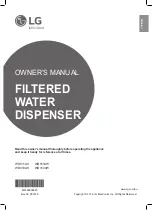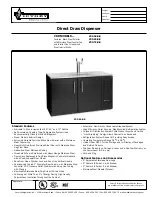
Installation Steps and Start-Up Procedures, Cont.
S
S
S
tep 4
Connect Gravity Overflow Connection
The overflow line drains away excess water should the
tank fill with too much water or the appliance
malfunction.
A.
Check that the overflow elbow is in the down
position.
B.
Connect 1/2-inch (12.7 mm) I.D. tubing (size
cannot be reduced) between the overflow fitting
and a floor drain, laundry tub, or other suitable
waste receptor. This tubing is not supplied with the
appliance. Ensure that the overflow line ends at a
drain that is at least 3 inches (76 mm) lower than
the bottom of the overflow fitting. Maintain a
minimum 2-inch air gap. The gravity line cannot be
run overhead.
tep 5
Connect Drain Line
The drain line carries away the backwash water as part
of the regeneration cycle.
A.
Connect the drain line to the drain end cap with a
minimum 1/2-inch (12.7 mm) I.D. tubing (supplied).
The size cannot be reduced.
B.
Route the drain line to a floor drain, laundry tub, or
other suitable waste receptor. Maintain a minimum
2-inch air gap between the drain line and the flood
level rim of the waste receptor to prevent
back-siphoning. This drain line should make the
shortest run to the suitable drain.
C.
The drain line may be elevated up to 8 feet from
the discharge on the appliance as long as the water
pressure in your system is 40 psi or more.
D.
If the drain line is 25 feet or longer, increase the
drain line to 3/4-inch I.D. The end of the drain line
must be equal to or lower in height than the control
valve.
Caution:
The drain line must not be kinked,
crimped, or restricted in any way.
tep 6
Flush Lines
A.
Place the appliance in the Bypass position.
B.
Turn on the main water supply.
Gravity
Overflow
Connection
Figure 6: Gravity Overflow Connection
Figure 7: Connect Drain Line
Figure 8: Bypass Position
C.
Open the nearest cold water faucet to flush the
plumbing of any excess soldering flux, air, or any
other foreign material.
HomeGuard
®
Owner’s Manual
9/29/2009
13














































